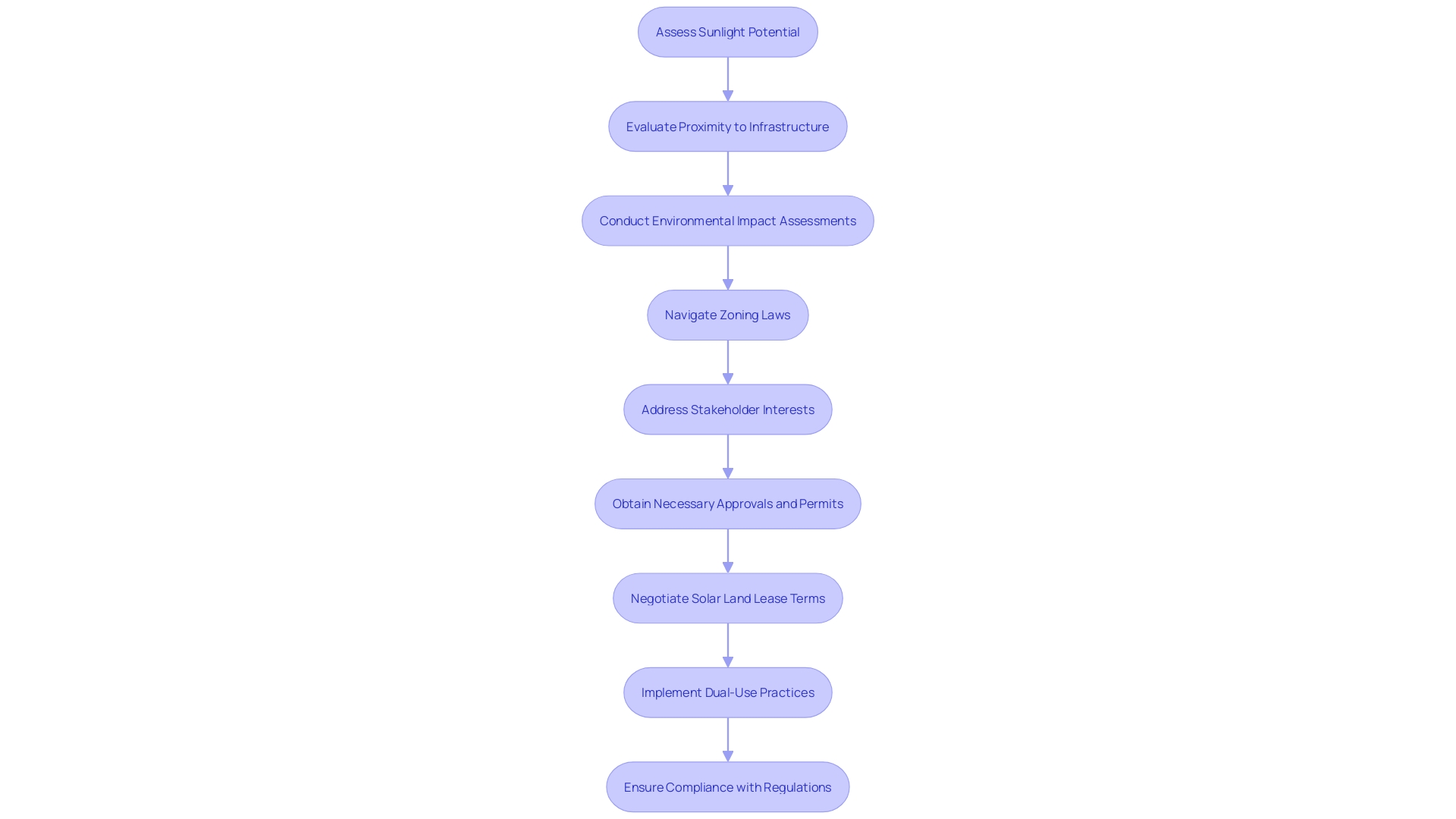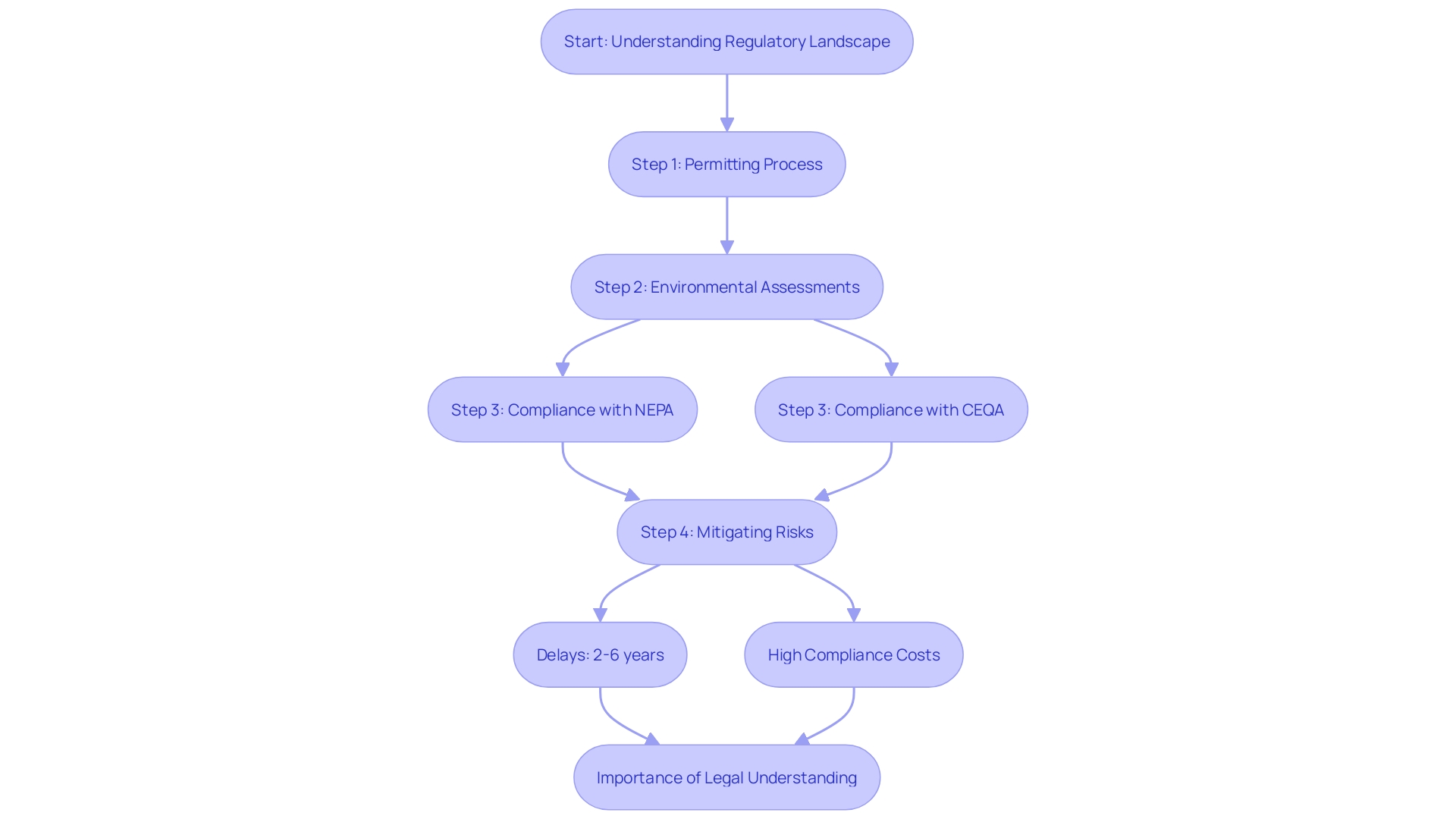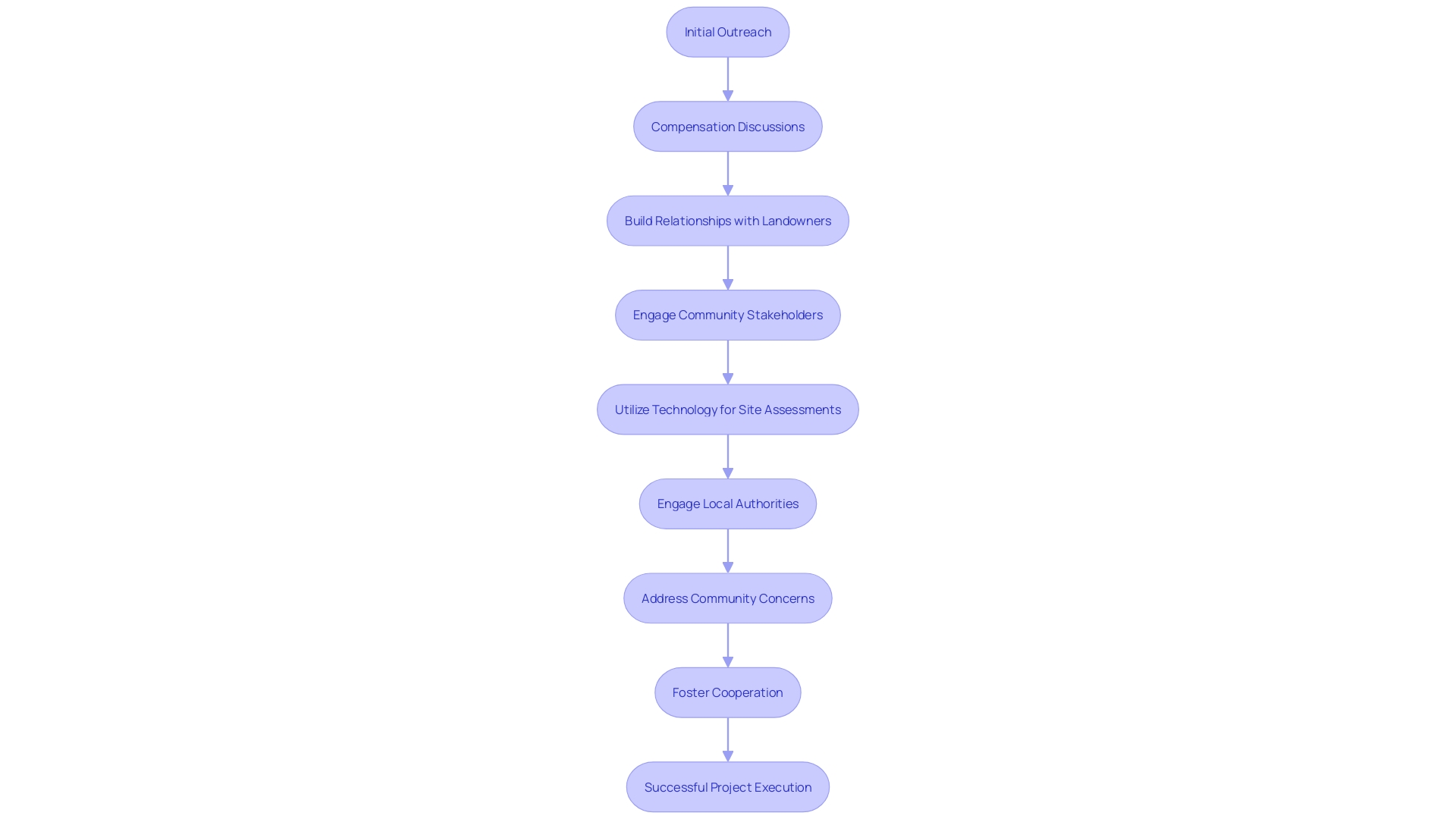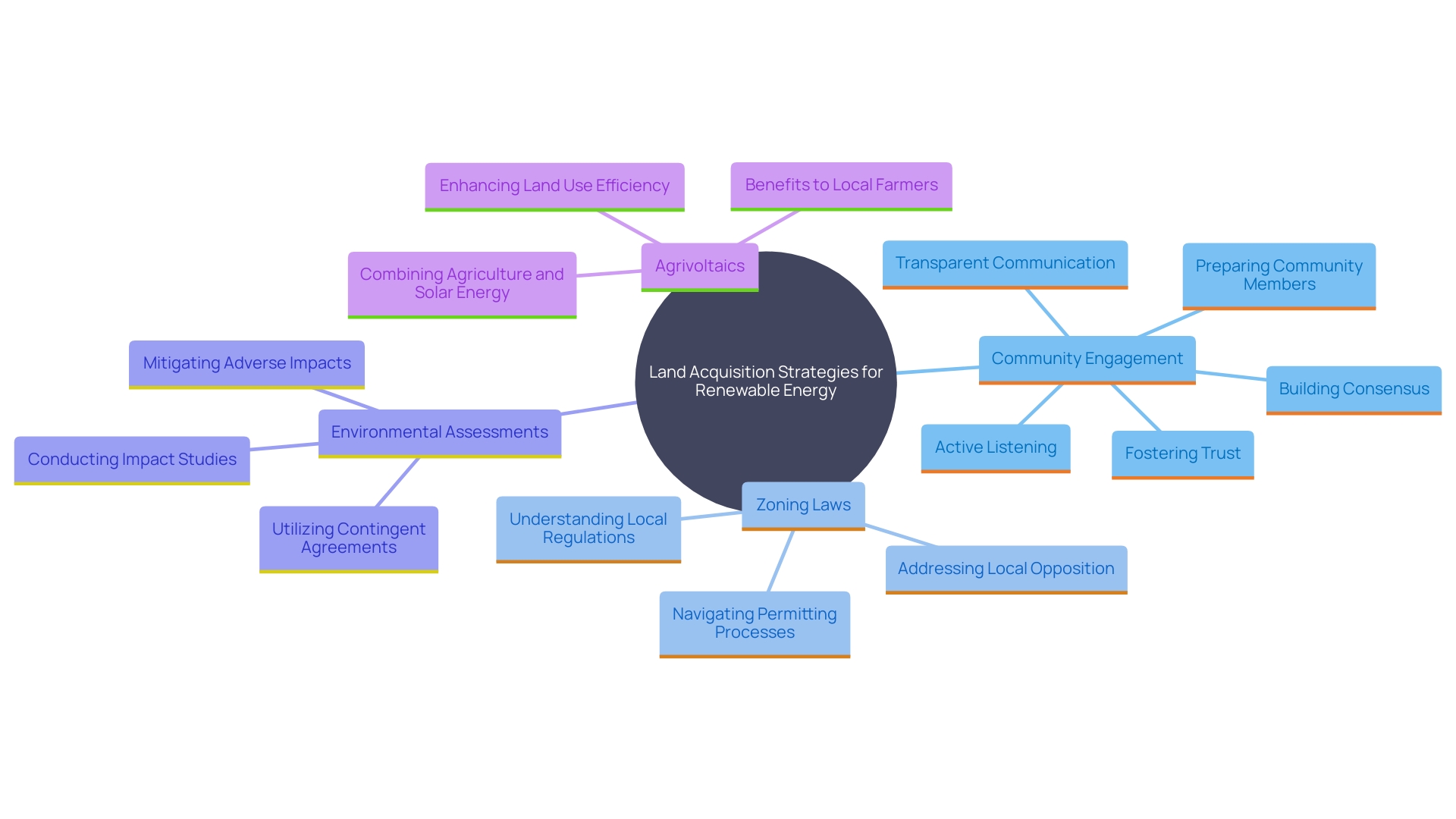Introduction
Land acquisition for solar projects is a complex and multifaceted process that requires careful evaluation and strategic planning. The location's solar potential, proximity to existing infrastructure, and compliance with environmental and regulatory requirements are critical factors that influence the feasibility and success of solar farm developments. Moreover, the integration of stakeholder interests, particularly those of local communities and governments, is essential to gain support and mitigate opposition.
Navigating the legal landscape presents significant challenges due to diverse and complex regulatory frameworks across regions. These variations can result in delays and increased compliance costs, making it imperative for developers to thoroughly understand and address legal requirements to mitigate risks.
Successful land acquisition strategies involve building strong relationships with landowners, offering fair compensation, and utilizing advanced technology for site assessments. Engaging with local governments and fostering transparent communication with stakeholders are also crucial steps in ensuring project alignment with community interests and addressing potential conflicts.
Real-world examples highlight the importance of tailored approaches to land acquisition that consider regional contexts and stakeholder interests. Innovative strategies such as agrivoltaics, which combine solar energy production with agricultural activities, demonstrate the potential for harmonious and sustainable land use solutions.
Key Considerations in Land Acquisition
Land acquisition for renewable energy initiatives involves a complex assessment process. One of the main factors is the site's sunlight potential, which directly affects the effectiveness and production of the energy farm. The proximity to existing infrastructure, such as power lines and roads, is another crucial factor, as it can significantly reduce the costs and complexities associated with transmitting the generated electricity to the grid.
An essential aspect of the acquisition process is the environmental impact assessment. This assessment guarantees that the advancement of the solar initiative does not negatively impact the regional ecosystem, which is a vital issue for regulatory approvals and community acceptance. Furthermore, comprehending and maneuvering through local zoning laws and usage regulations is essential. These laws can vary significantly by region and can influence the feasibility and timeline of the endeavor.
'Stakeholder interests are also a key component of the property acquisition strategy.'. Local communities and governments often have a vested interest in how the area is utilized, and their support or opposition can determine the success or failure of a project. For instance, incorporating dual-purpose methods, such as merging energy farms with farming activities, can assist in reducing conflicts and maximizing space utilization. This method not only tackles the issues of property owners but also enhances the financial advantages of the terrain.
Furthermore, the duration of renewable energy leases usually spans from twenty to thirty years, but this can be modified depending on discussions and particular contracts. During this period, landowners may engage in other activities, such as livestock grazing or farming, alongside the energy infrastructure, depending on the terms of the lease.
In summary, successful land acquisition for renewable energy initiatives requires a comprehensive understanding of various factors, including sunlight capacity, infrastructure proximity, environmental impact, regulatory compliance, and stakeholder interests. By addressing these considerations, developers can ensure a smoother acquisition process and foster positive relationships with local communities.

Legal and Regulatory Challenges
'Navigating the legal landscape for solar initiatives presents significant challenges due to the diverse and complex regulatory frameworks across regions.'. Regulatory variations influence permitting processes, environmental assessments, and land use rights, often resulting in delays and high compliance costs. For example, the National Environmental Policy Act (NEPA) and similar state laws like CEQA can add 2-6 years of delay and substantial compliance costs to any development project. This is especially important in the context of the swift expansion in renewable energy, where the U.S. photovoltaic sector installed 32.4 gigawatts-direct current (GWdc) of capacity in 2023 alone, marking a 51% increase over 2022. Legal issues may arise from land title disputes, easements, and the need to comply with various federal, state, and local regulations. As Jeff Marootian from the U.S. Department of Energy stated, "How renewable energy is planned and approved varies widely across the United States." Understanding these specific legal requirements and potential hurdles is essential to mitigate risks during the acquisition process and ensure the timely progression of renewable initiatives. 'The United States' dramatic growth in renewable energy, including wind, further underscores the importance of addressing these challenges effectively.'.

Strategies for Successful Land Acquisition
Attaining effective land procurement for renewable energy initiatives requires a thorough and tactical method. Establishing strong connections with landowners and community stakeholders is crucial to earning trust and collaboration. Offering fair compensation and addressing community concerns can streamline negotiations and mitigate opposition.
Utilizing advanced technology, such as GIS mapping and data analysis tools, significantly enhances site assessments and decision-making processes. These tools, utilized by numerous developers, assist in forecasting visibility problems and evaluating the appropriateness of locations for energy initiatives. For example, Inicio utilizes its internal algorithm, Eywa, to determine the best sites for power generation facilities while taking into account regional limitations like urban development, farming strategies, and conservation zones.
Engaging with local authorities early in the process is essential to align goals with community interests. This proactive involvement can assist in resolving possible disputes, such as the effects of sunlight installations on farming areas. As stated by Lauren McPhillips, assistant professor in agricultural and biological engineering, flat, well-draining areas suitable for farming are also excellent sites for photovoltaic installations, leading to a requirement for creative design strategies that reduce land-use disputes.
Moreover, understanding the dynamics of local opposition and fostering transparent communication are vital. Many stakeholders have legitimate concerns about the design and location of renewable energy facilities. Efficient community involvement and cooperation can create agreement and address resistance, guaranteeing the successful execution of renewable energy initiatives.

Case Studies: Real-world Examples of Land Acquisition for Solar Projects
Numerous real-life instances demonstrate efficient land acquisition tactics for renewable energy initiatives. For instance, the development of a large solar farm in California showcased the importance of navigating regional zoning laws and engaging with community stakeholders. This approach resulted in minimal opposition and a streamlined permitting process, addressing both community concerns and legal requirements. In the same way, an initiative in Arizona highlighted the critical role of environmental assessments. Developers collaborated with conservation groups to protect local wildlife, fostering community support and ensuring compliance with environmental regulations. These instances highlight the importance of customized strategies for property acquisition that take into account local circumstances and stakeholder interests, ultimately resulting in more effective and sustainable energy projects. Furthermore, the idea of agrivoltaics, which entails the shared use of terrain for both renewable energy and farming, is appearing as a promising approach. This approach not only maximizes land use but also mitigates potential conflicts between solar development and agricultural activities, paving the way for innovative and harmonious land use solutions.

Conclusion
Successful land acquisition for solar projects hinges on a comprehensive evaluation of various critical factors, including solar potential, infrastructure proximity, environmental impact, and regulatory compliance. Understanding local zoning laws and engaging with stakeholders, particularly local communities and governments, proves essential in fostering cooperation and support. By addressing these considerations, developers can navigate the complexities of land acquisition more effectively, ensuring that projects align with community interests and regulatory requirements.
The legal and regulatory landscape presents significant challenges that must be navigated meticulously. Varied regulations across regions can lead to delays and increased costs, making it imperative for developers to understand the specific legal requirements pertinent to their projects. Mitigating these risks is crucial for the timely advancement of solar initiatives, especially in light of the rapid growth of the renewable energy sector.
Employing strategic approaches, such as building strong relationships with landowners, utilizing advanced technology for site assessments, and engaging local governments early in the process, can enhance the likelihood of successful land acquisition. Real-world case studies demonstrate the effectiveness of tailored strategies that consider regional contexts and stakeholder interests, further emphasizing the importance of innovative solutions like agrivoltaics. These practices not only optimize land use but also foster community support and minimize conflicts, paving the way for sustainable solar energy development.




